Renewable energy generation across the Southeast Asian region has been long driven by the deployment of hydro-based solutions. Between 2000 and 2016, hydropower capacity in the region grew from nearly 16 GW to 44 GW, according to International Renewable Energy Agency (IRENA).
The region currently deploys two types of hydropower – large hydro and small hydro. Countries in the Mekong River Basin, including Cambodia, Lao PDR, Myanmar and Vietnam (CLMV), are leading this growth. The development of large hydro has been substantial whereby hydropower capacity has increased from 6 GW to 26 GW over the past 10 years.
Vietnam, in particular, has seen rapid growth in the deployment of large hydro, with substantial investments also flowing into Lao PDR, primarily for export purposes. In the region, a clear distinction is made between large and small hydropower; however, the threshold for defining small hydro varies across countries, for example, up to 10 MW in Indonesia, 15 MW in Lao PDR and Thailand, and 30 MW in Vietnam.
What does small hydropower do?
Small hydropower (also commonly known as small scale hydropower systems) capture the energy in flowing water and converts it into usable energy. Although the potential for small hydroelectric systems depends on the availability of suitable water flow, cheap and clean electricity can be produced wherever the resources exist.
Small scale hydropower has been used as a common method of generating electricity in remote regions. The systems are often put in small rivers, streams or within the existing water supply networks such as drinkable or waste product networks.
A well designed small hydropower system can blend in with its surroundings and have a minimal negative environmental impact as well.

Source: Renewable Energy Solutions
Small hydropower in Southeast Asia
Although small hydropower is deployed globally, there is still an untapped potential in most areas of the world including Southeast Asia. In recent times however, small hydropower has thrived in Southeast Asia, meeting localised energy needs and contributing to the development of local industry in some countries.
For example, the ASEAN Hydropower Competence Centre (HYCOM) in Bandung, Indonesia carries out region-wide knowledge exchanges on mini and micro hydropower which range from 1 kW to 1 MW. The objective of HYCOM is to provide a region-wide competence centre that offers training as well as facilitates research and development in the small hydropower sector. It is involved in providing training on standards, testing the reliability, safety and efficiency of micro hydropower equipment in laboratories, supporting the development of mini hydropower sites and facilitating networking and the exchange of micro hydropower-related information.
According to IRENA’s 2018 Renewable Energy Market Analysis report, it is stated that “…in terms of capacity, Vietnam, the Philippines, Thailand, Indonesia and Malaysia seem to be heading the pack for small hydropower.” With the abundance of rivers in Vietnam - approximately 2,200 rivers - it is no doubt that small hydropower can be further developed in the country. Though separated by seas and not having common major river systems, other countries in Southeast Asia such as Indonesia, Malaysia and Philippines also have high potential for hydropower.
Benefits of deploying small hydropower in the region
Apart from cost efficiency when compared to large scale or conventional hydropower systems, small hydro projects also have reduced environmental and social impacts compared to non-run of river projects, shorter and simpler development, less-intense finance and construction phases than larger projects.
With the potential to power rural areas, smaller countries such as the CLMV should consider utilising their rivers through small hydropower systems. Apart from that, the implementation of small hydro projects also requires a much lesser cost, which will further benefit smaller economies in the region.
As villages and rural communities become electrified, they will be more empowered to engage in economic activity which will further spur economic growth. For a developing region facing rapid industrialisation and growing populations, small hydropower must be seriously considered as a viable energy source that has useful potential to tap into.
